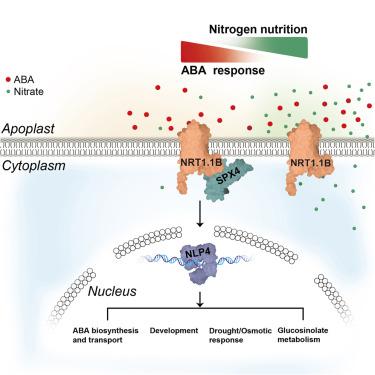nrt11 b作为脱落酸受体参与植物对复合环境信号的整合
IF 42.5
1区 生物学
Q1 BIOCHEMISTRY & MOLECULAR BIOLOGY
引用次数: 0
摘要
脱落酸(ABA)是植物适应环境条件最重要的激素。虽然植物中的ABA信号网络已被广泛探索,但我们对各种ABA传感系统的了解仍然有限。在这里,我们发现ABA的转录反应在高硝酸盐条件下被抑制,但在低硝酸盐条件下显著增加,这表明ABA信号与营养条件紧密结合。有趣的是,NRT1.1B,传统上被认为是硝酸盐转运体和受体,对ABA表现出明显更高的亲和力,导致ABA促进NRT1.1B- spx4复合物的形成。该复合体触发spx4隔离的转录因子NLP4的释放,从而启动对ABA的转录反应。这些发现表明nrt11 b具有ABA受体的功能。值得注意的是,硝酸盐和ABA与nrt11 b的竞争性结合揭示了一种机制,使ABA能够对波动的营养条件做出灵活的反应,说明了一种整合复合环境线索的复杂策略。本文章由计算机程序翻译,如有差异,请以英文原文为准。

NRT1.1B acts as an abscisic acid receptor in integrating compound environmental cues for plants
Abscisic acid (ABA) is the most crucial phytohormone for plants in adapting to environmental conditions. While the ABA signaling network in plants has been extensively explored, our understanding of the diverse ABA sensing systems remains limited. Here, we found that the transcriptional response to ABA is suppressed under high-nitrate conditions but substantially increases under low-nitrate conditions, suggesting a tight integration of ABA signaling with nutrient conditions. Interestingly, NRT1.1B, traditionally recognized as a nitrate transporter and receptor, exhibits a markedly higher affinity for ABA, leading to the formation of an ABA-facilitated NRT1.1B-SPX4 complex. This complex triggers the release of SPX4-sequestered transcription factor NLP4, thereby initiating the transcriptional response to ABA. These findings establish that NRT1.1B functions as an ABA receptor. Notably, the competitive binding of nitrate and ABA to NRT1.1B unveils a mechanism that enables a flexible ABA response to fluctuating nutrient conditions, illustrating a sophisticated strategy for integrating compound environmental cues.
求助全文
通过发布文献求助,成功后即可免费获取论文全文。
去求助
来源期刊

Cell
生物-生化与分子生物学
CiteScore
110.00
自引率
0.80%
发文量
396
审稿时长
2 months
期刊介绍:
Cells is an international, peer-reviewed, open access journal that focuses on cell biology, molecular biology, and biophysics. It is affiliated with several societies, including the Spanish Society for Biochemistry and Molecular Biology (SEBBM), Nordic Autophagy Society (NAS), Spanish Society of Hematology and Hemotherapy (SEHH), and Society for Regenerative Medicine (Russian Federation) (RPO).
The journal publishes research findings of significant importance in various areas of experimental biology, such as cell biology, molecular biology, neuroscience, immunology, virology, microbiology, cancer, human genetics, systems biology, signaling, and disease mechanisms and therapeutics. The primary criterion for considering papers is whether the results contribute to significant conceptual advances or raise thought-provoking questions and hypotheses related to interesting and important biological inquiries.
In addition to primary research articles presented in four formats, Cells also features review and opinion articles in its "leading edge" section, discussing recent research advancements and topics of interest to its wide readership.
 求助内容:
求助内容: 应助结果提醒方式:
应助结果提醒方式:


